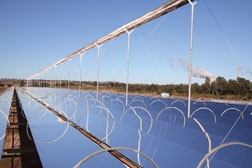| 300-MW Array and More Planned for Florida, California | ||
| Tagline | ||
| 10/03/2007 | ||
| By Debra Wood | ||
| One of Florida's largest electric utilities plans to produce power using the Sunshine State's namesake beams at a new 300-MW solar thermal plant, larger than any single thermal solar array now operating in the country. FPL Group Inc., Juno Beach, and subsidiaries Florida Power & Light and FPL Energy anticipate investing $1.5 billion at solar facilities in Florida and California during the next seven years. About $900 million will be committed to Florida, says Mayco Villafana, FPL spokesman.
"It's a wonderful step forward and we're very excited about it," says Tom Mancini, concentrating solar power manager for Sandia National Laboratories, Albuquerque, N.M. FPL Energy already operates two solar facilities totaling 310 MW in the Mohave Desert, using parabolic trough technology, which requires on-site installation of high support trusses, custom-curved mirrors and troughs containing solar heated oil. The newly announced FPL plants will employ Palo Alto, Calif.-based Ausra Inc.'s compact linear fresnel reflector solar collector and steam generation system. Architectural mirror glass attaches to panels that rotate on hoops installed close to the ground and shine sunlight on the absorber, a pipe running above. "We focused on making the reflector area cheaper," says John O'Donnell, Ausra executive vice president. "The slightly curved steel decking and truss is manufactured on a production line and the reflectors are bonded to it." Heat storage will allow the plants to run at night or in cloudy weather. A steam accumulator stores energy as pressurized hot water, driving a turbine when the valve is open. "All costs associated with the turbine and cooling systems will be amortized over more hours of generation," O'Donnell says. "As you add energy storage, the cost per kilowatt-hour drops." Mancini says solar power generation in the Southwest costs 12¢ to 15¢ per kWh. The average retail cost of electricity in Florida in 2005 was 8.76¢ per kWh, reports the Energy Information Administration. Combining large concentrating solar plants with conventional natural-gas combined-cycle or coal-fired plants could lower the cost of solar to 8¢ per kWh, the Dept. of Energy estimates. That is Ausra's plan for FPL's initial 10-MW pilot project. It will feed the solar plant's steam into an existing gas-fired power station, O'Donnell says. Warm Welcome Acceptance by consumer and environmental activists could smooth permitting and siting. Bill Newton, executive director of the Florida Consumer Action Network, praised the plant. Audubon of Florida also is pleased with FPL's solar plans. "This is a fantastic idea, and we're happy to see FPL take the lead in renewable energy," says Traci Romine, a policy advocate working on climate change for Audubon of Florida. FPL will assess whether the pilot project meets cost and technical specifications for three years before proceeding with the 300-MW facility. Gov. Charlie Crist (R) has called for reducing utility greenhouse gas emissions, and the Public Service Commission is studying the plan. Ausra estimates, depending on financing costs, it can generate power for 4.8¢ to 6.7¢ per kWh. "We are on the threshold of solar power more or less being a direct competitor with gas-fired generation, and over the next few years with coal-fired generation," O'Donnell says. He estimates the installed cost of the 300-MW plant will be about $3 million per MW. Florida's humid climate reduces direct solar radiation and increases solar's costs, says Mancini. But land cost is the main issue holding back Florida's solar development, says Jim Fenton, executive director of the Florida Solar Energy Center, Cocoa. He speculates FPL will locate solar arrays around a nuclear plant, where they must maintain a large land buffer. FPL owns and operates nuclear plants near Fort Pierce and Florida City. | ||
Friday, April 4, 2008
300-MW Array and More Planned for Florida, California
Subscribe to:
Post Comments (Atom)
Blog Archive
-
▼
2008
(81)
-
▼
April
(34)
- Parabolic Trough Thermal Energy Storage Technology
- eSolar Announces Breakthrough Pre-Fabricated Solar...
- Google-Backed Solar Startup Picks Up Steam, $130 M...
- Solar Concentrating Systems -- CIEMAT Review Article
- Inauguration of new Fresnel collector at Plataform...
- Solar energy even at night: DLR breakthrough with ...
- Solar thermal power
- MAN Ferrostaal enters solar cooling market
- MAN Ferrostaal expands its solar business
- Solar power is becoming cheaper
- Fresnel technology: on the way to mass production
- David Mills talks about the global political envir...
- New Ways to Store Solar Energy for Nighttime and C...
- The Race Between Two Forms of Sunlight
- Mega Solar: the World’s 13 Biggest Solar Thermal E...
- Orb Energy Awarded $1 Million for Solar Solutions ...
- Ahead of the curve? Fresnel technology in CSP
- Australian National University -- Bibliography on ...
- PS10 cost analysis
- Ausra promises Utility-scale solar power at market...
- Ausra Shining Brightly Over The Pacific
- Aussie Solar Startup Takes on Silicon Valley
- 300-MW Array and More Planned for Florida, California
- Baseload renewable power at utility-scale is here ...
- Ausra's Bold Plan
- Ausra’s Solar Thermal Power
- Ten facts about solar thermal power (Solel site)
- RIL to set up semiconductor fab, solar photovoltai...
- Bill Boyne: It's time to get serious about solar e...
- Solel to add solar facilities in Spain
- Solar Energy Generating Systems
- Solar Thermal Power: Simple and Increasingly Effec...
- Solar Thermal Electricity: Catching the Eye of Uti...
- BrightSource Energy signs whopper solar contract w...
-
▼
April
(34)

No comments:
Post a Comment